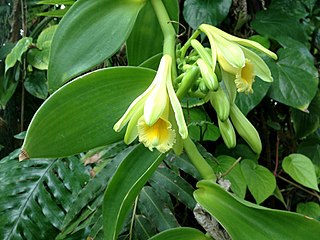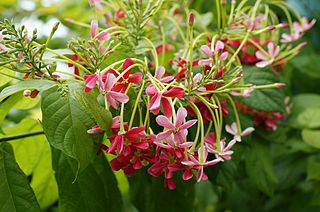
A bean is the seed of several plants in the family Fabaceae, which are used as vegetables for human or animal food. They can be cooked in many different ways, including boiling, frying, and baking, and are used in many traditional dishes throughout the world.

Kiwifruit or Chinese gooseberry is the edible berry of several species of woody vines in the genus Actinidia. The most common cultivar group of kiwifruit is oval, about the size of a large hen's egg: 5–8 centimetres in length and 4.5–5.5 cm in diameter. It has a thin, fuzzy, fibrous, tart but edible light brown skin and light green or golden flesh with rows of tiny, black, edible seeds. The fruit has a soft texture with a sweet and unique flavour.

Vanilla is a spice derived from orchids of the genus Vanilla, primarily obtained from pods of the flat-leaved vanilla (V. planifolia).

Feijoa sellowiana also known as Acca sellowiana (O.Berg) Burret, is a species of flowering plant in the myrtle family, Myrtaceae. It is native to the highlands of southern Brazil, eastern Paraguay, Uruguay, and northern Argentina. Feijoa are also common in gardens of New Zealand. It is widely cultivated as an ornamental tree and for its fruit. Common names include feijoa, pineapple guava and guavasteen, although it is not a true guava. It is an evergreen shrub or small tree, 1–7 metres (3.3–23.0 ft) in height.

Phaseolus is a genus of herbaceous to woody annual and perennial vines in the family Fabaceae containing about 70 plant species, all native to the Americas, primarily Mesoamerica.

Legumes are plants in the family Fabaceae, or the fruit or seeds of such plants. When used as a dry grain for human consumption, the seeds are also called pulses. Legumes are grown agriculturally, primarily for human consumption; for livestock forage and silage; and as soil-enhancing green manure. Well-known legumes include beans, soybeans, chickpeas, peanuts, lentils, lupins, grass peas, mesquite, carob, tamarind, alfalfa, and clover. Legumes produce a botanically unique type of fruit – a simple dry fruit that develops from a simple carpel and usually dehisces on two sides.

The mung bean, alternatively known as green gram, mungo bean or mongo bean, is a plant species in the legume family. The mung bean is mainly cultivated in East, Southeast and South Asia. It is used as an ingredient in both savoury and sweet dishes.

Phaseolus coccineus, known as runner bean, scarlet runner bean, or multiflora bean, is a plant in the legume family, Fabaceae. Another common name is butter bean, which, however, can also refer to the lima bean, a different species.

Phaseolus vulgaris, the common bean, is a herbaceous annual plant grown worldwide for its edible dry seeds or green, unripe pods. Its leaf is also occasionally used as a vegetable and the straw as fodder. Its botanical classification, along with other Phaseolus species, is as a member of the legume family Fabaceae. Like most members of this family, common beans acquire the nitrogen they require through an association with rhizobia, which are nitrogen-fixing bacteria.

The tamarillo is a small tree or shrub in the flowering plant family Solanaceae. It is best known as the species that bears the tamarillo, an egg-shaped edible fruit. It is also known as the tree tomato, tomate de árbol, tomate andino, tomate serrano, blood fruit, poor man's tomatoe, tomate de yuca, tomate de españa, sachatomate, berenjena, chilto and tamamoro in South America, tyamtar, rambheda or rukh tamatar in Nepal, and terong Belanda in Indonesia. It is popular globally, especially in Peru, Colombia, New Zealand, Ecuador, Nepal, Rwanda, Burundi, Australia, Bhutan and the United States.

Vigna umbellata, previously Phaseolus calcaratus, is a warm-season annual vine legume with yellow flowers and small edible beans. It is commonly called ricebean or rice bean. To date, it is little known, little researched and little exploited. It is regarded as a minor food and fodder crop and is often grown as intercrop or mixed crop with maize, sorghum or cowpea, as well as a sole crop in the uplands, on a very limited area. Like the other Asiatic Vigna species, ricebean is a fairly short-lived warm-season annual. Grown mainly as a dried pulse, it is also important as a fodder, a green manure and a vegetable. Ricebean is most widely grown as an intercrop, particularly of maize, throughout Indo-China and extending into southern China, India, Nepal and Bangladesh. In the past it was widely grown as lowland crop on residual soil water after the harvest of long-season rice, but it has been displaced to a great extent where shorter duration rice varieties are grown. Ricebean grows well on a range of soils. It establishes rapidly and has the potential to produce large amounts of nutritious animal fodder and high quality grain.

The asparagus bean is a legume cultivated for its edible green pods containing immature seeds, like the green bean. It is also known as: yardlong bean, pea bean, long-podded cowpea, Chinese long bean, snake bean, bodi, and bora. Despite the common name of "yardlong", the pods are actually only about half a yard long, so the subspecies name sesquipedalis is a more accurate approximation.

Green beans are young, unripe fruits of various cultivars of the common bean, although immature or young pods of the runner bean, yardlong bean, and hyacinth bean are used in a similar way. Green beans are known by many common names, including French beans, string beans, and snap beans or simply "snaps." In the Philippines, they are also known as "Baguio beans" or "habichuelas" to distinguish them from yardlong beans.

Thunbergia alata, commonly called black-eyed Susan vine, is a herbaceous perennial climbing plant species in the family Acanthaceae. It is native to Eastern Africa, and has been naturalized in other parts of the world.

Araujia sericifera is a perennial vining plant in the genus Araujia, of the family Apocynaceae, that is native to South America. The species was described in 1817 by the Portuguese botanist Félix de Avelar Brotero. The synonym Araujia hortorum is in more frequent use in New Zealand. Its common names include bladderflower, white bladderflower, bladder vine, cruel vine, cruel plant, moth plant, moth vine, common moth vine, and false choko.

Combretum indicum, also commonly known as the Rangoon creeper or Burma creeper, is a vine with red flower clusters which is native to tropical Asia and grows in thickets, primary and secondary forest, and along river banks in the Indian subcontinent, Malaysia and the Philippines. It has since been cultivated and naturalized in tropical areas such as Burma, Vietnam, and Thailand.

Vigna marina is a prostrate, creeping vine and a perennial plant. Also known as the beach pea, nanea, and notched cowpea, it is a species of legume in the family Fabaceae.

Cardiospermum grandiflorum, commonly known as showy balloonvine, heart pea or heart seed, is a species of climbing plant native to eastern Argentina and Brazil.

Vigna angularis, also known as the adzuki bean(Japanese: 小豆, azuki, Uncommon アヅキ, adzuki), azuki bean, aduki bean, red bean, or red mung bean, is an annual vine widely cultivated throughout East Asia for its small bean. The cultivars most familiar in East Asia have a uniform red color, but there are also white, black, gray, and variously mottled varieties.

Vigna luteola, commonly known as the hairy cowpea and the Nile bean, is a perennial vine found in many tropical areas.


























